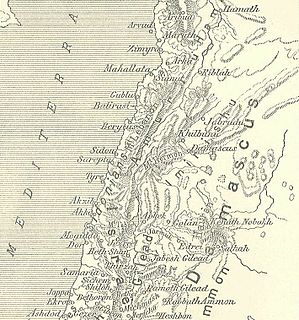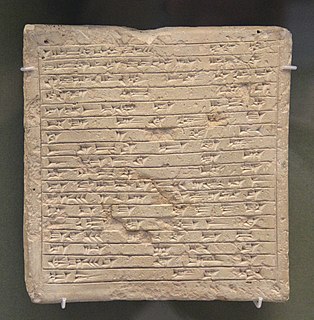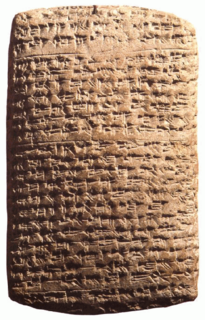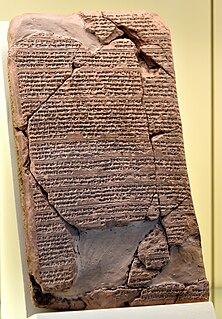 W
WIn the 1350 BC correspondence of 382–letters, called the Amarna letters, the prostration formula is usually the opening subservient remarks to the addressee, the Egyptian pharaoh. The formula is based on prostration, namely reverence and submissiveness. Often the letters are from vassal rulers or vassal city-states, especially in Canaan but also in other localities.
 W
WAbdi-Ashirta was the ruler of Amurru who was in conflict with King Rib-Hadda of Byblos.
 W
WAbdi-Heba was a local chieftain of Jerusalem during the Amarna period. Abdi-Heba's name can be translated as "servant of Hebat", a Hurrian goddess. Whether Abdi-Heba was himself of Hurrian descent is unknown, as is the relationship between the general populace of pre-Israelite Jerusalem and the Hurrians. Egyptian documents have him deny he was a mayor (ḫazānu) and assert he is a soldier (we'w), the implication being he was the son of a local chief sent to Egypt to receive military training there.
 W
WAmarna Letter EA10 is the letter of the Amarna series of diplomatic correspondence designated EA 10, which is written in cuneiform writing showing the continuation of a correspondence between Burna-Buriash II an ancient king of Babylon, and Akhenaten, an ancient pharaoh of Egypt.
 W
WAmmunira was a king of Beirut in the mid-fourteenth century BCE. He is mentioned in several of the Amarna letters, and authored letters EA 141-43.
 W
WArqa (Arabic: عرقا; canaanite: Irqata also in phonecian is a Sunni village near Miniara in Akkar Governorate, Lebanon, 22 km northeast of Tripoli, near the coast.
 W
WAshur-uballit I (Aššur-uballiṭ I), who reigned between 1365 and 1330 BC, was the first king of the Middle Assyrian Empire. After his father Eriba-Adad I had broken Mitanni influence over Assyria, Ashur-uballit I's defeat of the Mitanni king Shuttarna II marks Assyria's ascendancy over the Hurri-Mitanni Empire, and the beginning of its emergence as a powerful empire. Later on, due to disorder in Babylonia following the death of the Kassite king Burnaburiash II, Ashur-uballit established Kurigalzu II on the Babylonian throne, in the first of what would become a series of Assyrian interventions in Babylonian affairs.
 W
WAyyab was a ruler of Aštartu (present day Tell Ashtara [Tell 'Aštara], south of Damascus. According to the Amarna letters, cities/city-states and their kings in the region — just like countries to the north, such as Hatti of the Hittites — fell prey to a wave of attacks by Habiru raiders. The Amarna correspondence corpus covers a period from 1350–1335 BC.
 W
WAziru was the Canaanite ruler of Amurru, modern Lebanon, in the 14th century BC. He was the son of Abdi-Ashirta, the previous Egyptian vassal of Amurru and a direct contemporary of Akhenaten.
 W
WBiridiya was the ruler of Megiddo in the 14th century BC. Biridiya authored five of the Amarna letters correspondence. He is also mentioned in the corpus from the city of 'Kumidu', the Kamid al lawz.
 W
WBurna-Buriaš II, rendered in cuneiform as Bur-na- or Bur-ra-Bu-ri-ia-aš in royal inscriptions and letters, and meaning servant or protégé of the Lord of the lands in the Kassite language, where Buriaš is a Kassite storm god possibly corresponding to the Greek Boreas, was a king in the Kassite dynasty of Babylon, in a kingdom contemporarily called Karduniaš, ruling ca. 1359–1333 BC, where the Short and Middle chronologies have converged. Recorded as the 19th King to ascend the Kassite throne, he succeeded Kadašman-Enlil I, who was likely his father, and ruled for 27 years. He was a contemporary of the Egyptian Pharaoh Akhenaten. The proverb "the time of checking the books is the shepherds' ordeal" was attributed to him in a letter to the later king Esarhaddon from his agent Mar-Issar.
 W
WArqa (Arabic: عرقا; canaanite: Irqata also in phonecian is a Sunni village near Miniara in Akkar Governorate, Lebanon, 22 km northeast of Tripoli, near the coast.
 W
WKadašman-Enlil I, typically rendered mka-dáš-man-dEN.LÍL in contemporary inscriptions, was a Kassite King of Babylon from ca. 1374 BC to 1360 BC, perhaps the 18th of the dynasty. He is known to have been a contemporary of Amenhotep III of Egypt, with whom he corresponded. This places Kadašman-Enlil securely to the first half of the 14th century BC by most standard chronologies.
 W
WLabaya was a 14th-century BCE ruler or warlord in the central hill country of southern Canaan. He lived contemporaneously with Pharaoh Akhenaten. Labaya is mentioned in several of the Amarna Letters. He is the author of letters EA 252–54.
 W
WNaziba, was a small 'city', or 'city-state' south of Dimašqu-(Damascus), in the 1350–1335 BC Amarna letters correspondence. The town of Naziba was located near Amarna letters Qanu, now named Qanawat, and biblical Kenath.
 W
WNiqmaddu II was the second ruler and king of Ugarit, an ancient Syrian citystate in northwestern Syria, reigning c. 1350–1315 BC and succeeding his less known father, Ammittamru I. He took his name from the earlier Amorite ruler Niqmaddu, meaning "Addu has vindicated" to strengthen the supposed origins of his Ugaritic dynasty in the Amorites.
 W
WPu-Ba'lu, was ruler/mayor of Yursa,, identified with Tell Jemmeh, of the 1350–1335 BC Amarna letters correspondence. His name translates in west semitic as well as in Akkadian as: "word/mouth (of) Baal", the 'Spokesman (of) Baal' ,.
 W
WRib-Hadda was king of Byblos during the mid fourteenth century BCE. He is the author of some sixty of the Amarna letters all to Akhenaten. His name is Akkadian in form and may invoke the Northwest Semitic god Hadad, though his letters invoke only Ba'alat Gubla, the "Lady of Byblos".
 W
WSuppiluliuma I or Suppiluliumas I was king of the Hittites. He achieved fame as a great warrior and statesman, successfully challenging the then-dominant Egyptian Empire for control of the lands between the Mediterranean and the Euphrates.
 W
WTunip was a city-state in western Syria in 1350–1335 BC, the period of the Amarna letters. The name "Syria" did not yet exist, though this was already the time of ancient Assyria. The regions were: Amurru, Nuhašše, the Amqu, Nii, etc.
 W
WTushratta or Tyshratha / Thesh·ratha was a king of Mitanni at the end of the reign of Amenhotep III and throughout the reign of Akhenaten—approximately the late 14th century BC. He was the son of Shuttarna II. His sister Gilukhipa and his daughter Tadukhipa were married to the Egyptian pharaoh Amenhotep III; Tadukhipa later married Akhenaten who took over his father's royal harem.